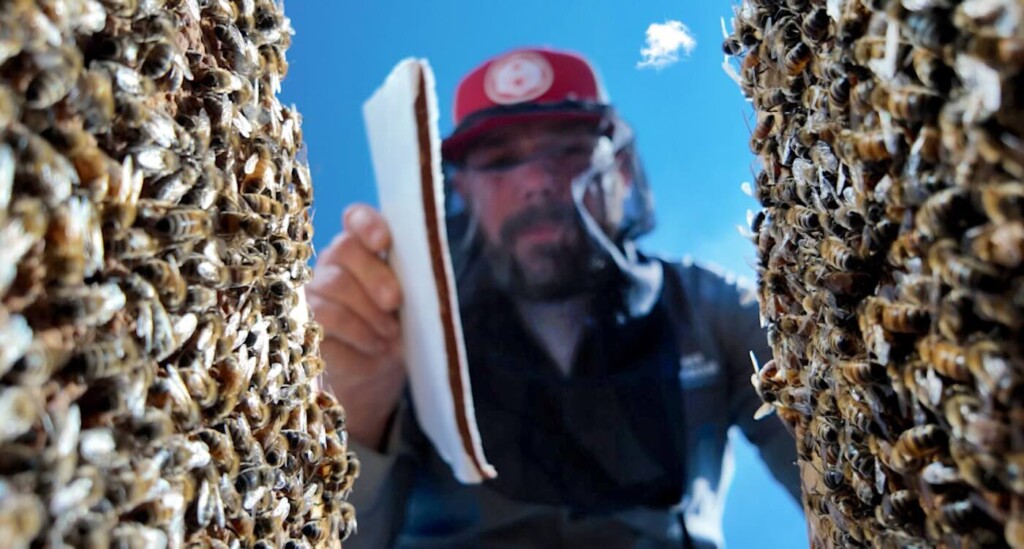Pollen Replacement Food for Honey Bees Brings New Hope for Struggling Colonies and the Crops They Support
Pollen Replacement Food for Honey Bees Brings New Hope for Struggling Colonies and the Crops They Support
Scientists have unveiled a new food source designed to sustain honey bee colonies indefinitely without natural pollen.
The research from Washington State University and APIX Biosciences in Belgium details successful trials where nutritionally stressed colonies, deployed for commercial crop pollination in Washington state, thrived on the new food source.
The innovation resembles human “Power Bars” and contains all the nutrients honey bees need. It’s expected to become a potent strategy for combating the rate of colony collapse and safeguarding global farm crops that depend on bee pollination.
Placed directly into honey bee colonies where young bees process and distribute the essential nutrients to the larvae and adult bees, the breakthrough addresses the growing challenge of lack of adequate nutrition in their environment.
“Changes in land use, urban expansion, and extreme weather all negatively impact nutrition for honey bees and other pollinators,” Brandon Hopkins, WSU Professor of Pollinator Ecology, explained in a media release.
“Honey bees are generalists and do not get all their nutrition from a single source. They need variety in their diet to survive but find it increasingly difficult to find the continuous supply of pollen they need to sustain the colony.”
“Until this study, honey bees were the only livestock that could not be maintained on a man-made feed,” said Dr. Patrick Pilkington, CEO of APIX Biosciences US.
“The reported scientific work shows in commercial field conditions that providing nutritionally stressed colonies with our pollen-replacing feed results in a major measurable step change in colony health compared to current best practices. Our product has the potential to change the way honey bees are managed.”
‘Herculean’ effort by 3 teams
 WSU Professor Brandon Hopkins places the newly developed bee food into a hive – Credit: College of Agricultural, Human, and Natural Resource Sciences, WSU
WSU Professor Brandon Hopkins places the newly developed bee food into a hive – Credit: College of Agricultural, Human, and Natural Resource Sciences, WSUThe research, published this month in the journal Proceedings of the Royal Society B, is a culmination of over a decade of work involving extensive collaboration.
“The newly published work is the result of a herculean scientific effort of three teams,” said Thierry Bogaert, lead author and chairman of APIX Biosciences.
“First, the founders and scientists of APIX Biosciences who tested thousands of combinations of ingredients on honey bees over more than 10 years to create this feed. Second, the WSU team with leading honey bee and field expertise, and, third, leading beekeepers in California together with extension teams. They made large scale and science-based field testing of feeds possible.” (Paper co-author Anne Marie Fauvel managed that third aspect.)
A critical discovery within the research is the role of isofucosterol, a molecule found naturally in pollen that acts as a vital nutrient for honey bees. Colonies fed with the isofucosterol-enriched food survived an entire season without pollen access, while those without it experienced severe declines, including reduced larval production, adult paralysis, and colony collapse. The new feed also contains a comprehensive blend of the other nutrients honey bees require.
To validate the efficacy of the new food source under real-world conditions, WSU conducted field trials with nutritionally stressed colonies in blueberry and sunflower fields, both known for poor pollen quality for bees. Compared to colonies receiving standard commercial feed or no supplementation, those fed the new food source thrived, demonstrating increased survival and colony growth.
“Some beekeepers don’t pollinate blueberries anymore because colonies suffer or die and the pollination fees don’t cover the losses,” said WSU Prof. Hopkins, a co-author of the paper.
“Blueberry pollen isn’t very nutritious for honey bees, and they aren’t adapted well to pollinating that crop. But if they have this supplemental food source, beekeepers may return to pollinating those fields since they know their bees are more likely to survive.”
Pilkington summarized the team’s optimism saying they are working with the beekeeping community across the U.S. to develop the best way to make use of this new tool in agricultural settings.
“We are confident that the product will positively impact beekeepers and growers once it’s available to purchase in the U.S., which is targeted for mid-2026.”

댓글
댓글 쓰기